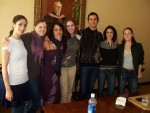Title
Hearing that Wally Cardona was to be the guest artist at a Lunch With an Alum on November 19, I was immediately interested, knowing that Cardona is a well-established dancer, choreographer, and Juilliard alumnus who has a company here in New York City. Conceived in 1997, the Wally Cardona Quartet officially made its debut in 1998 at the Joyce Theater’s Altogether Different Festival, and has introduced new forms of movement to audiences, using multimedia collaborations and experimentation in its performances. Cardona’s evening-length, abstract “landscape” works present dancers interacting not just with each other, but with their surrounding space and the shifting terrain of objects that create the performance setting. His work has been presented at the Brooklyn Academy of Music’s Next Wave Festival, the Portland (Ore.) Institute for Contemporary Art, and the Jacobs Pillow Dance Festival, as well as in Austria, Belgium, France, Portugal, Korea, Mexico, and Canada. Cardona received a 2006 John Simon Guggenheim Fellowship, as well as a 2006 New York Dance and Performance (“Bessie”) Award.
Body
Walking into the President’s Board Room, impressed by the delicious arrangement of cookies, salad, and pasta, and knowing the incredible work Cardona has done, I had already set my mind on the questions I was going to ask him. But another dancer spoke first and posed one of the most pressing and important questions on everyone’s minds, considering the current economic climate: “How has the economic state affected your company, and what direction do you plan to take?”
After a smile and a few quick seconds of thought, Cardona answered that he had felt a direct effect on the life of his company, as well as within his own life. The New York State Council of the Arts, he explained, “had a big scare” recently; under a proposal put forth by the governor just the previous week, its $48 million budget would be cut by $7 million, and the council was facing many uncertainties. Cardona’s work outside the city would be affected as well; his commission to create a new piece in Philadelphia this year had also been subject to cuts, and he had been forced to trim in various ways, replacing live musicians with recorded music and employing fewer dancers in the piece. Recently, he admitted, he had even resisted the urge to go shopping for new shirts! Though budget cuts are an issue every artist has to face, Cardona had an extremely optimistic outlook on the development of his company and his own work. “There is a lot of holding back in the arts, due to a fear of losing money,” he said. “So I believe in continuously putting in and creating more energy. Theater attendance is down in general, so I must keep creating.”
But how do we keep creating if the funds are absent? How does a graduating dancer get a job if choreographers are cutting back within their own companies? Cardona explained that, until he literally runs out of money, he will make it his goal to bring work to audiences, offering his interesting artistic perspective. “As an artist,” he said, “I strongly believe, if anyone knows how to be resilient with the context at hand, it’s us.” We artists, he said, are the only ones who can continue to create work—which brings people into the audiences again, and presents a strong outlook on the issues our society is dealing with.
The discussion then turned to what he looks for in a dancer. Cardona spoke about how he strives to create movement by showing off the artistry of each of his dancers, allowing them to use their techniques as a stepping stone to create something using their own points of view. He looks for technically proficient, opinionated dancers who have a strong grasp on reality and can reveal the truth and reality of our everyday lives. He says his work is “not for mass consumption … it’s not fast food”—so it is not always what people want to see, but it is true to his dancers and to his own life. In his press materials, he explains it thus: “In the interplay between the building of object, dancer and sound, I hope the viewer’s eye and attention begin to operate on a level of multiplicity, traveling to diverse places and drawing … newly personal connections between the character of a fallen object, a hand held, a horn blown, or a space left bare. I like to think of these works as an invitation to follow the performers through the unpredictable and fragile nature of building life onstage …”
As the meeting wrapped up, I headed out of the room to my next class with a newfound hope and confidence in American modern dance. Even if there is a crisis at hand, there are still artists like Cardona, who will continue to create works and explore persistently with interesting viewpoints and ideas about dance.





